Elisa Zaccaria, Francesco Gualco, Francesco Drago and Alfredo Rebora
Department of Dermatology, DISEM, University of Genoa, Viale Benedetto XV n.7, IT-16100 Genova, Italy. E-mail: lonetti@unige.it
Accepted March 13, 2006.
Sir,
A 61-year-old Caucasian woman was referred to our department because of a skin eruption of one-month duration that had begun one month after the onset of therapy with propranolol. She had been diagnosed as having chronic active hepatitis due to hepatitis C virus infection, but denied any previous skin disorder. She had been treated for hypertension with 10 mg/day propranolol oraly for the previous 2 months. No other medications had been taken and she had not previously received β-blocking therapy.
On examination, she exhibited a sharply marginated, round, itchy plaque of erythema and oedema, 1.5×3 cm in size with violaceous and bullous centre, localized on the external face of her right leg (Fig. 1). Laboratory disclosed leukopaenia (2.6×109/l) with a normal differential count, thrombocytopaenia (84×109/l), a small increase in liver enzyme activity, positive IgG FTA-ABS, and positive Treponema pallidum haemo-agglutination test (1/160). Hepatitis C virus serology was suggestive of previous infection.
Fig. 1. Marginated, round plaque with violaceous and bullous centre on the right leg.

A skin biopsy specimen showed a sub-epidermal bulla with acanthosis, focal parakeratosis, hypergranulosis and focal necrosis of keratinocytes. The upper dermis was infiltrated by lymphocytes and granulocytes, but signs of leukocytoclastic vasculitis were absent. These findings were compatible with the diagnosis of fixed drug eruption. The propranolol therapy was immediately discontinued and after 2 months of treatment with topical methylprednisolone once a day, the skin lesion had cleared.
Our patient had a skin lesion that both clinically and histopathologically recalled a fixed drug eruption. The close relationship with the propranolol treatment and its clearance after discontinuation suggest propranolol as the most likely culprit. β-adrenoreceptor blocking agents, including propranolol hydrochloride, have been repeatedly reported to induce skin eruptions (1–3). The clinical features of the latter are variable (psoriasiform (2), lichenoid (1–4), maculopapular or with lupus-like appearance (5)), but fixed drug eruption has never been described.
The number of drugs able to produce fixed drug eruptions is very large. In the UK, they mostly include non-steroidal anti-inflammatory drugs and non-opioid analgesics, sulphonamides and tetracyclines (6). This is the first case in which propranolol can be incriminated.
How β-blockers may induce skin lesions is unclear. Pochet et al. (7) demonstrated β-adrenoreceptors on both T- and B-lymphocytes, but did not explain their relationship with the sensitization to β-blockers. The expression of adrenoreceptors β1 and β2 differ in various tissues (8) and in various skin regions. The regional differences in their expression may explain the different types of skin reaction. Immunological mechanisms have been suggested to explain the cutaneous eruptions due to β-blocking agents, but the evidence, which included various cutaneous tests (1), failed to clarify whether a type I or IV reaction is responsible. In any case, dermatologists should be aware of the possibility of these side-effects in patients during treatment with β-blocking drugs.
REFERENCES
1. Felix RH, Comaish JS. The value of patch and other skin tests in drug eruptions. Lancet 1974; 1: 1017–1019.
2. Jensen HA, Mikkelsen HI, Wadskov S, Sondergaard J. Cutaneous reactions to propranolol (Inderal). Acta Med Scand 1976; 199: 363–367.
3. Neumann Ham, Van Joost T, Westerhof W. Dermatitis as side effect of long-term metoprolol. Lancet 1979; 2: 745.
4. Cochran RE, Thomson J, Mcqueen A, Beevers DG. Letter: skin reactions associated with propranolol. Arch Dermatol 1976; 112: 1173–1174.
5. Hughes GR. Hypotensive agents, beta-blockers, and drug-induced lupus. BMJ 1982; 284: 1358–1359.
6. Savin JA. Current causes of fixed drug eruption in the UK. Br J Dermatol 2001; 145: 667–668.
7. Pochet R, Delespesse G, Gausset PW, Collet H. Distribution of beta-adrenergic receptors on human lymphocyte subpopulations. Clin Exp Immunol 1979; 38: 578–584.
8. Ahlquist RP. Adrenergic receptors in the cardiovascular system, In: Saxena RR, Forsyth RP, eds. β-adrenoreceptor blocking agents. New York: Elsevier North Holland Inc., 1976: p. 29–35.
